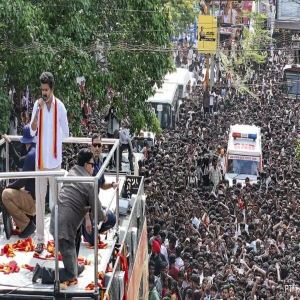
.png) M L Satyan
M L Satyan
.jpg)
The following news sent shock waves all over the country: On September 27, 2025, at least 41 people were killed and around 100 others were injured in a crowd crush during a political rally in Karur district, Tamil Nadu, India. The rally was hosted by the film star Vijay, the founder and president of the Tamizhaga Vettri Kazhagam (TVK).
Various theories began to emerge soon after this stampede. One such theory doing the rounds is that Vijay and his team used the occasion to shoot parts of his forthcoming movie, Jana Nayagan. Purportedly, they wanted to shoot a vast crowd gathered to see him, so they used 63 sophisticated drone cameras. Also, unbeknownst to the innocent fans, Vijay's caravan housed other cameras.
Two days ago, a few YouTube channels presented the interviews of some of the family members of the victims of the stampede. Surprisingly, they were all unanimous in showering praise on Vijay rather than abuse. During the interview, one woman says, "My child's death is just a compensation for seeing Vijay closely."
The victims' kith and kin do not consider the stampede deaths as a big loss. The crowd that waited for Vijay made many sacrifices – skipped food and water and controlled their nature calls - as there were no such arrangements at the venue. Do we need any other example of film-star worship and fanaticism?
The author has worked in many parts of the northern states but has never witnessed film star worship there. The southern states of Andhra Pradesh, Telangana, Karnataka and Tamil Nadu have one thing in common – movie fanaticism. What right do these states have to boast of other developments in education, health and industrial sectors?
In India, there is a group of temples dedicated to celebrities, including film stars, sportspersons and even politicians. These temples are built and maintained by die-hard fans of these famous people. It is an extreme form of showing their love and admiration for these celebrities. From film releases to temples built for movie stars, India's obsession with film personalities is unmatched. But when this admiration turns into blind hero worship, it becomes a growing concern, especially for the country's youth.
The practice of star worship in India dates back to the 1940s and 50s, when legendary actors like MG Ramachandran (MGR) and NT Rama Rao (NTR) became icons not just on-screen but also in real life. They portrayed mythological heroes and social reformers, and fans began seeing them as more than actors—almost divine.
This admiration turned political when both entered politics, further blurring the line between real-life leadership and reel-life heroism. Since then, the phenomenon has only grown, especially in South Indian states where fans perform rituals, celebrate star birthdays like festivals, and even build temples in their honour. After MGR and NTR, Jayalalitha too became a star-turned-political heroine. The films she acted in did not make her popular. But when she entered politics, she tried to wield her authority and power over her party and people.
A big part of the problem is how the film industry markets celebrities. Stars are promoted as larger-than-life figures. Media and social platforms create a 24/7 buzz around them, feeding the illusion that they are flawless and God-like. While loving cinema is natural, the extreme level of obsession is harming young people in serious ways:
1. Loss of Reality: Many teenagers mimic their favourite stars - from their style and dialogue to their behaviour, leading to unrealistic life expectations and disappointment when things do not match up.
2. Academic and Career Neglect: Some fans skip school, college, or work to attend movie releases or fan club activities. Social media becomes a space for endless debates and unproductive hero worship, taking away from real personal development.
3. Toxic Fan Wars: Supporters of different stars often fight online - and sometimes even in real life. These fan rivalries promote hate and violence, undermining healthy social behaviour.
4. Emotional and Mental Health Risks: Fans often tie their self-worth to a star's success or failure. If an actor faces criticism or tragedy, it deeply affects them. Cases of depression, anxiety, and even suicide have been reported.
We do not need to stop watching movies, but we do need to help young people draw the line between entertainment and obsession.
What can be done?
1. Media literacy could be promoted in schools. Students must be taught to analyse films and examine them critically.
2. Kids need to be taught to value themselves for who they are, not their fan status.
3. Young boys and girls could be encouraged to see film actors as artists and not idols. The film heroes and heroines should never become their role models.
4. Debates could be organised among youth to encourage them to discuss openly the differences between fiction and real life.
5. Awareness-building programs could be conducted among rural communities to help them understand that the film heroes/heroines rarely, if ever, become real-life heroes/heroines.
Cinema is powerful, and film stars deserve appreciation but not worship. It is time to move from blind fanaticism to healthy admiration. By helping youth and the general public think critically and prioritise their own growth, we can enjoy movies without losing ourselves in them.